100000
Type of resources
Available actions
Topics
INSPIRE themes
Keywords
Contact for the resource
Provided by
Years
Formats
Representation types
Update frequencies
status
Scale
Resolution
-
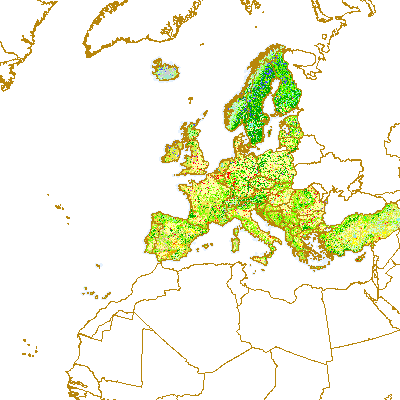
CLC00 is one of the datasets produced within the frame the Corine Land Cover programme referring to land cover / land use status of year 2000. The Corine Land Cover (CLC) is an European programme, coordinated by the European Environment Agency (EEA), providing consistent information on land cover and land cover changes across Europe. CLC products are based on the photointerpretation of satellite images by the national teams of the participating countries - the EEA member or cooperating countries. The resulting national land cover inventories are further integrated into a seamless land cover map of Europe. The resulting European database is based on standard methodology and nomenclature with following base parameters: - 44 classes in the hierarchical 3-level Corine nomenclature - minimum mapping unit (MMU) for status layers is 25 hectares - minimum width of linear elements is 100 metres - minimum mapping unit (MMU) for Land Cover Changes (LCC) for change layers is 5 hectares CLC programme provides important data sets supporting the implementation of key priority areas of the Environment Action Programmes of the European Community as protecting ecosystems, halting the loss of biological diversity, tracking the impacts of climate change, assessing developments in agriculture and implementing the EU Water Framework Directive etc.. CLC programme is also a part of the Global Monitoring for Environment and Security (GMES http://gmes.info) initiative, run by the European Commission and the European Space Agency, which will provide environmental information from a combination of air- and space-based observation systems and in-situ monitoring. More about the Corine Land Cover (CLC) programme and datasets can be found at http://www.eea.eu.
-

This dataset contains information on individual points of discharge from treatment plants or collecting systems, localisation of discharge, link to specific treatment plant, type of receiving area into which the effluent/wastwater is dicharged, related waterbody (or river basin), information on the discharge on land. The table T_ReceivingAreas (uwwtd_receivingareas_v4.txt) summarises information on designated sensitive areas, date of designation, the purpose of the designation, type of sensitive areas. Moreover, the table specifies which particular article of the UWWTD is applied in regards to designation of sensitive areas.
-
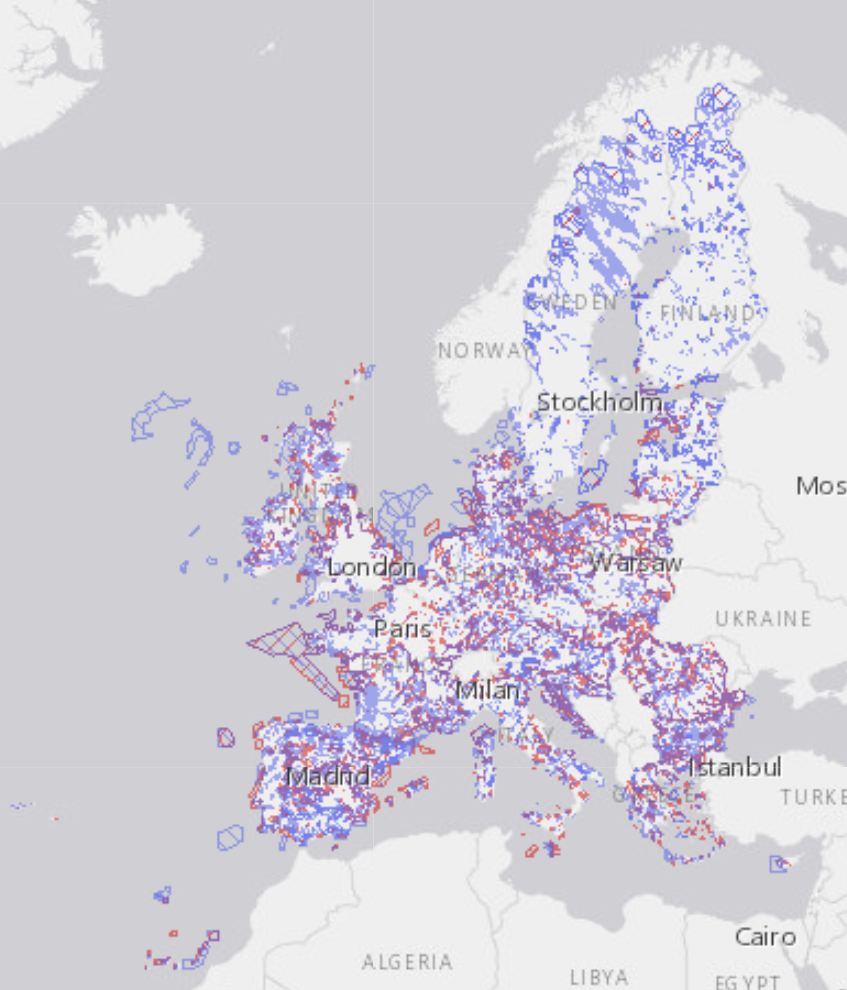
Natura 2000 is the key instrument to protect biodiversity in the European Union. It is an ecological network of protected areas, set up to ensure the survival of Europe's most valuable species and habitats. Natura 2000 is based on the 1979 Birds Directive and the 1992 Habitats Directive. This version covers the reporting in 2019. Natura 2000 is an ecological network composed of sites designated under the Birds Directive (Special Protection Areas or SPAs) and the Habitats Directive (Sites of Community Importance or SCIs, and Special Areas of Conservation or SACs). The European database of Natura 2000 sites consists of a compilation of the data submitted by the Member States of the European Union. This European database is generally updated once a year to take into account any updating of national databases by Member States. However, the release of a new EU-wide database does not necessarily mean that a particular national dataset has recently been updated. The descriptive data in the European database are based on the information that national authorities have submitted, for each of the Natura 2000 sites, through a site-specific standard data form (SDF). In addition to other site-specific information, the standard data form provides the list of all species and habitat types for which a site is officially designated. The spatial data (outlining the boundaries of sites) submitted by each Member State are validated by the European Environment Agency (EEA). Any problems identified through the above validation procedures in the national datasets are brought to the attention of the Member States concerned. However, it remains up to the Member States to decide whether to submit a revised dataset before the European database is updated. The EEA therefore cannot guarantee that all inconsistences detected in national datasets are removed in the European dataset. Please note that some Member States have submitted sensitive information that has been filtered out of this database. The following Member States have submitted sensitive information: Austria, Belgium, Cyprus, Estonia, Finland, France, Germany, Ireland, Italy, Latvia, Lithuania, Luxembourg, Malta, Poland, Portugal, Slovakia, Spain, Sweden and United Kingdom. This concerns mainly species associated to specific sites. All reference to these species has been removed from the related sites. If this sensitive information is necessary to your field of research, please contact the Member State administrations individually. You can find a compiled list of national or regional Natura 2000 websites at the following address: http://ec.europa.eu/environment/nature/natura2000/db_gis/index_en.htm#sites There are specific terms and conditions relating to the use of downloaded boundary data within the United Kingdom. If you intend to use the UK data, you must first agree to the end-user licence http://www.jncc.gov.uk/page-5232. Besides the web service link provided in the metadata, the following services provide information on species and habitat types inside the Natura 2000 sites: https://bio.discomap.eea.europa.eu/arcgis/rest/services/ProtectedSites/Natura2000Habitats/MapServer https://bio.discomap.eea.europa.eu/arcgis/rest/services/ProtectedSites/Natura2000Species/MapServer NOTE: The dataset has been corrected in June 2020 and the files uploaded on the SDI on 30 July 2020. Files downloaded before that date has one invalid site type code (G) that was corrected (to B) in June.
-

CLC00_revised is one of the datasets produced within the frame the Corine Land Cover programme referring to land cover / land use status of year 2000. The Corine Land Cover (CLC) is an European programme, coordinated by the European Environment Agency (EEA), providing consistent information on land cover and land cover changes across Europe. CLC products are based on the photointerpretation of satellite images by the national teams of the participating countries - the EEA member or cooperating countries. The resulting national land cover inventories are further integrated into a seamless land cover map of Europe. The resulting European database is based on standard methodology and nomenclature with following base parameters: - 44 classes in the hierarchical 3-level Corine nomenclature - minimum mapping unit (MMU) for status layers is 25 hectares - minimum width of linear elements is 100 metres - minimum mapping unit (MMU) for Land Cover Changes (LCC) for change layers is 5 hectares CLC programme provides important data sets supporting the implementation of key priority areas of the Environment Action Programmes of the European Community as protecting ecosystems, halting the loss of biological diversity, tracking the impacts of climate change, assessing developments in agriculture and implementing the EU Water Framework Directive etc.. CLC programme is also a part of the Global Monitoring for Environment and Security (GMES http://gmes.info) initiative, run by the European Commission and the European Space Agency, which will provide environmental information from a combination of air- and space-based observation systems and in-situ monitoring. More about the Corine Land Cover (CLC) programme and datasets can be found at http://www.eea.eu.
-

CLC06 is one of the datasets produced within the frame the Corine Land Cover programme referring to land cover / land use status of year 2006. The Corine Land Cover (CLC) is an European programme, coordinated by the European Environment Agency (EEA), providing consistent information on land cover and land cover changes across Europe. CLC products are based on the photointerpretation of satellite images by the national teams of the participating countries - the EEA member or cooperating countries. The resulting national land cover inventories are further integrated into a seamless land cover map of Europe. The resulting European database is based on standard methodology and nomenclature with following base parameters: - 44 classes in the hierarchical 3-level Corine nomenclature - minimum mapping unit (MMU) for status layers is 25 hectares - minimum width of linear elements is 100 metres - minimum mapping unit (MMU) for Land Cover Changes (LCC) for change layers is 5 hectares CLC programme provides important data sets supporting the implementation of key priority areas of the Environment Action Programmes of the European Community as protecting ecosystems, halting the loss of biological diversity, tracking the impacts of climate change, assessing developments in agriculture and implementing the EU Water Framework Directive etc.. CLC programme is also a part of the Global Monitoring for Environment and Security (GMES http://gmes.info) initiative, run by the European Commission and the European Space Agency, which will provide environmental information from a combination of air- and space-based observation systems and in-situ monitoring. More about the Corine Land Cover (CLC) programme and datasets can be found at http://www.eea.europa.eu
-
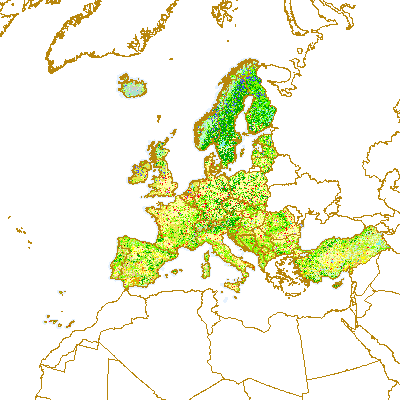
CLC06 is one of the datasets produced within the frame the Corine Land Cover programme referring to land cover / land use status of year 2006. The Corine Land Cover (CLC) is an European programme, coordinated by the European Environment Agency (EEA), providing consistent information on land cover and land cover changes across Europe. CLC products are based on the photointerpretation of satellite images by the national teams of the participating countries - the EEA member or cooperating countries. The resulting national land cover inventories are further integrated into a seamless land cover map of Europe. The resulting European database is based on standard methodology and nomenclature with following base parameters: - 44 classes in the hierarchical 3-level Corine nomenclature - minimum mapping unit (MMU) for status layers is 25 hectares - minimum width of linear elements is 100 metres - minimum mapping unit (MMU) for Land Cover Changes (LCC) for change layers is 5 hectares CLC programme provides important data sets supporting the implementation of key priority areas of the Environment Action Programmes of the European Community as protecting ecosystems, halting the loss of biological diversity, tracking the impacts of climate change, assessing developments in agriculture and implementing the EU Water Framework Directive etc.. CLC programme is also a part of the Global Monitoring for Environment and Security (GMES http://gmes.info) initiative, run by the European Commission and the European Space Agency, which will provide environmental information from a combination of air- and space-based observation systems and in-situ monitoring. More about the Corine Land Cover (CLC) programme and datasets can be found at http://www.eea.eu.
-

This dataset contains information on agglomerations with generated load ≥ 2000 P.E., including names, coordinates, generated load and information whether the load generated is collected through collecting system or addressed via Individual Appropriate Systems (IAS) or not collected not addressed via IAS.
-
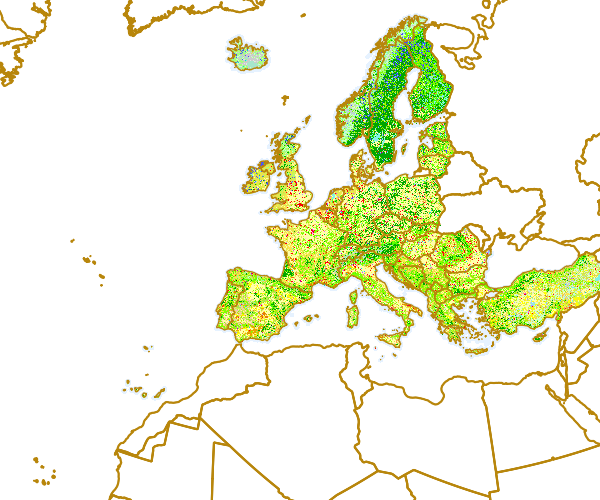
CLC00 is one of the datasets produced within the frame the Corine Land Cover programme referring to land cover / land use status of year 2000. The Corine Land Cover (CLC) is an European programme, coordinated by the European Environment Agency (EEA), providing consistent information on land cover and land cover changes across Europe. CLC products are based on the photointerpretation of satellite images by the national teams of the participating countries - the EEA member or cooperating countries. The resulting national land cover inventories are further integrated into a seamless land cover map of Europe. The resulting European database is based on standard methodology and nomenclature with following base parameters: - 44 classes in the hierarchical 3-level Corine nomenclature - minimum mapping unit (MMU) for status layers is 25 hectares - minimum width of linear elements is 100 metres - minimum mapping unit (MMU) for Land Cover Changes (LCC) for change layers is 5 hectares CLC programme provides important data sets supporting the implementation of key priority areas of the Environment Action Programmes of the European Community as protecting ecosystems, halting the loss of biological diversity, tracking the impacts of climate change, assessing developments in agriculture and implementing the EU Water Framework Directive etc.. CLC programme is also a part of the Global Monitoring for Environment and Security (GMES http://gmes.info) initiative, run by the European Commission and the European Space Agency, which will provide environmental information from a combination of air- and space-based observation systems and in-situ monitoring. More about the Corine Land Cover (CLC) programme and datasets can be found at http://www.eea.europa.eu
-

CLC06 is one of the datasets produced within the frame the Corine Land Cover programme referring to land cover / land use status of year 2006. The Corine Land Cover (CLC) is an European programme, coordinated by the European Environment Agency (EEA), providing consistent information on land cover and land cover changes across Europe. CLC products are based on the photointerpretation of satellite images by the national teams of the participating countries - the EEA member or cooperating countries. The resulting national land cover inventories are further integrated into a seamless land cover map of Europe. The resulting European database is based on standard methodology and nomenclature with following base parameters: - 44 classes in the hierarchical 3-level Corine nomenclature - minimum mapping unit (MMU) for status layers is 25 hectares - minimum width of linear elements is 100 metres - minimum mapping unit (MMU) for Land Cover Changes (LCC) for change layers is 5 hectares CLC programme provides important data sets supporting the implementation of key priority areas of the Environment Action Programmes of the European Community as protecting ecosystems, halting the loss of biological diversity, tracking the impacts of climate change, assessing developments in agriculture and implementing the EU Water Framework Directive etc.. CLC programme is also a part of the Global Monitoring for Environment and Security (GMES http://gmes.info) initiative, run by the European Commission and the European Space Agency, which will provide environmental information from a combination of air- and space-based observation systems and in-situ monitoring. More about the Corine Land Cover (CLC) programme and datasets can be found at http://www.eea.eu.
-
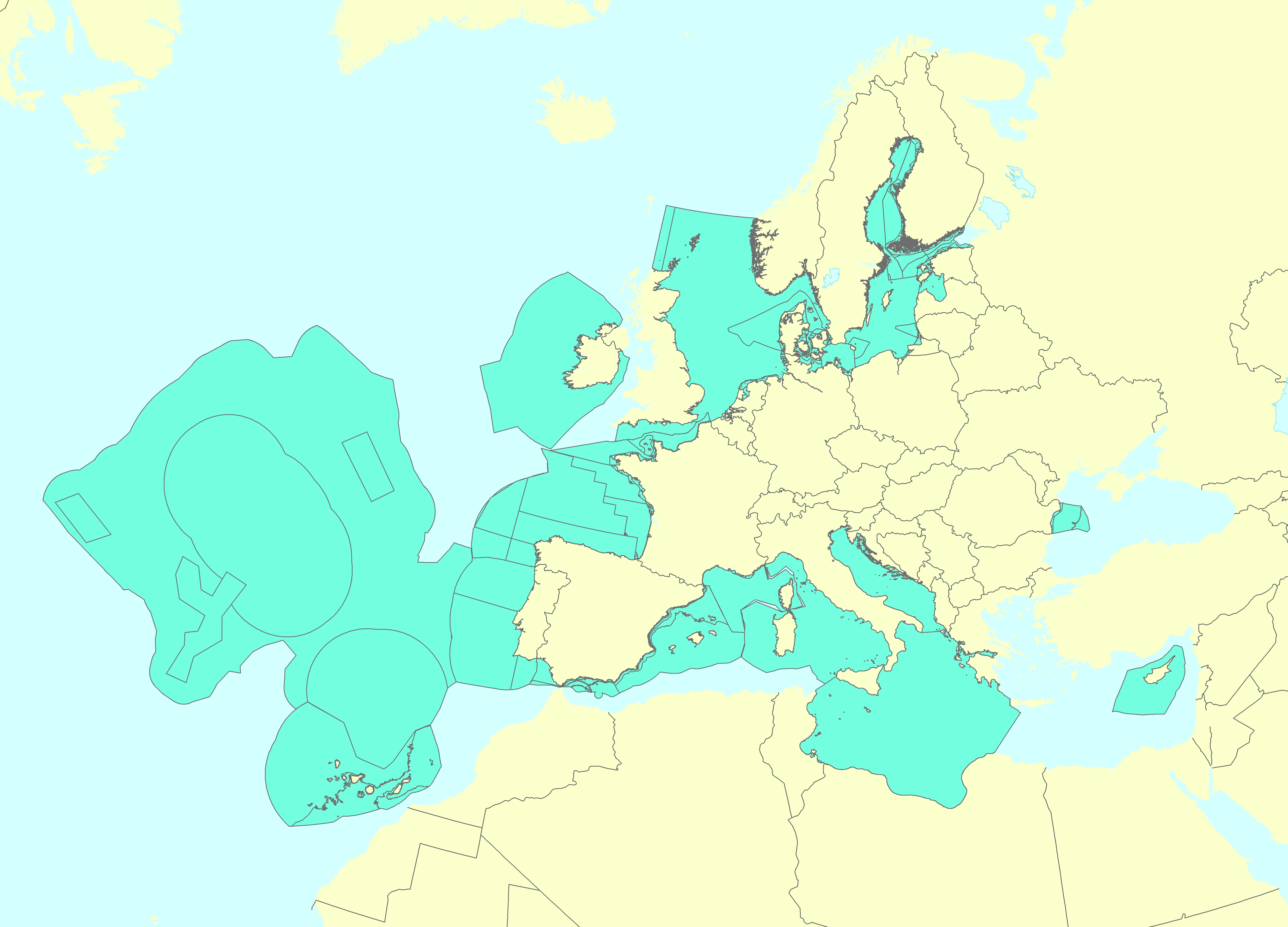
The Marine Reporting Units (MRUs) are used within the reporting obligations of the Marine Strategy Framework Directive (MSFD) in order to link the implementation of the different articles to specific marine areas. The MRUs can be of varying sizes, according to the appropriate scale for the different reports (e.g. region, sub-region, regional or sub-regional subdivision, Member State marine waters, WFD coastal waters, etc.), as indicated in the Good Environmental Status 2017 Decision. The present data set is the second public version released of the MRUs used during the MSFD 2018 reporting exercise on the update of Articles 8, 9 and 10. Only the MRUs of those countries that have gone through the reporting exercise by June 2020 have been included in this data set. Apart from the countries included already in version 1 of the dataset (SE, FI, EE, LV, PL, DE, DK, NL, BE, FR, ES, HR and RO), this version also includes seven more countries, namely MT, LT, IT, SI, CY, PT and IE. The data set is distributed in SHP and in INSPIRE-compliant GML format, made available also through an INSPIRE compliant ATOM service.
 RUC Geo-Data catalogue
RUC Geo-Data catalogue